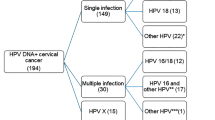Abstract
The polymerase chain reaction has been used to determine the presence of human papillomavirus (HPV) 16 and HPV 18 DNA sequences in archival histological material removed from a cohort of untreated women with cervical epithelial abnormalities. The detection of HPV 16 or HPV 18 DNA sequences in the initial biopsy specimen was associated with a significantly increased risk of subsequent disease progression.
This is a preview of subscription content, access via your institution
Access options
Subscribe to this journal
Receive 24 print issues and online access
$259.00 per year
only $10.79 per issue
Buy this article
- Purchase on Springer Link
- Instant access to full article PDF
Prices may be subject to local taxes which are calculated during checkout
Similar content being viewed by others
Author information
Authors and Affiliations
Rights and permissions
About this article
Cite this article
Woodman, C., Rollason, T., Ellis, J. et al. Human papillomavirus infection and risk of progression of epithelial abnormalities of the cervix. Br J Cancer 73, 553–556 (1996). https://doi.org/10.1038/bjc.1996.96
Issue Date:
DOI: https://doi.org/10.1038/bjc.1996.96



